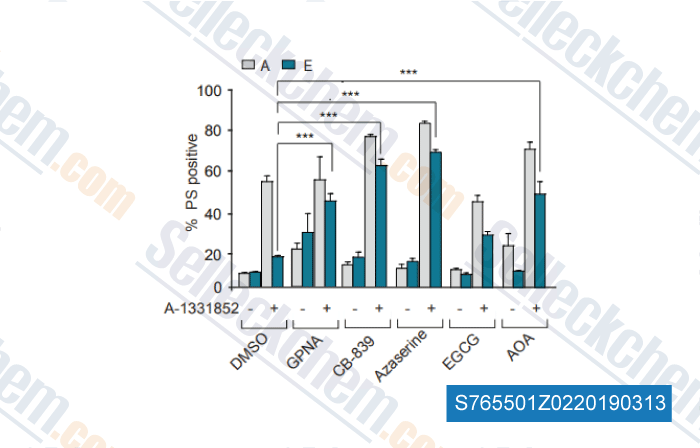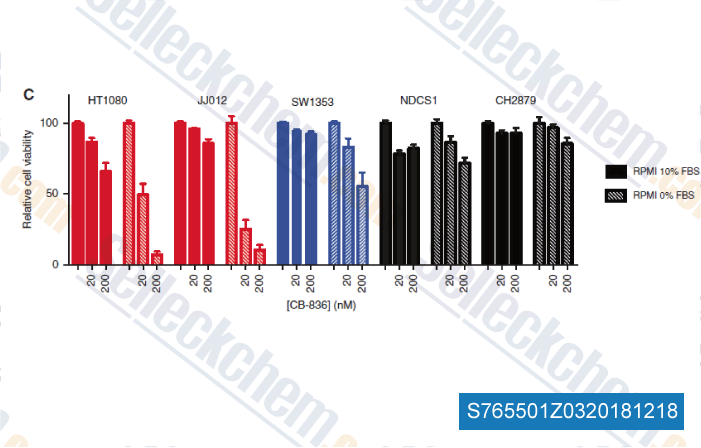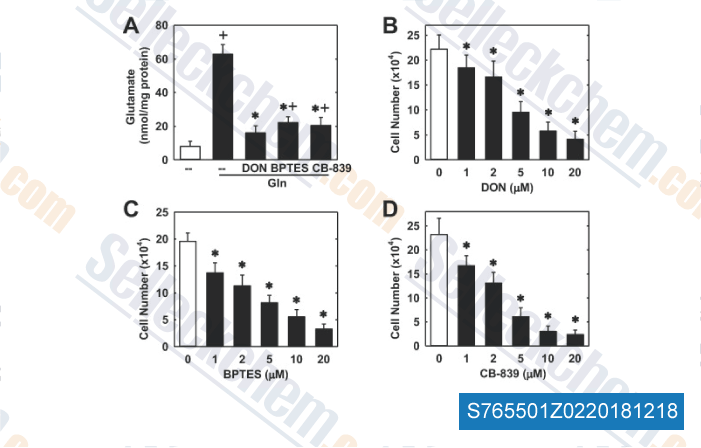|
Toll Free: (877) 796-6397 -- USA and Canada only -- |
Fax: +1-832-582-8590 Orders: +1-832-582-8158 |
Tech Support: +1-832-582-8158 Ext:3 Please provide your Order Number in the email. |
Technical Data
| Formula | C26H24F3N7O3S |
||||||||||
| Molecular Weight | 571.57 | CAS No. | 1439399-58-2 | ||||||||
| Solubility (25°C)* | In vitro | DMSO | 100 mg/mL (174.95 mM) | ||||||||
| Water | Insoluble | ||||||||||
| Ethanol | Insoluble | ||||||||||
| In vivo (Add solvents to the product individually and in order) |
|
||||||||||
|
* <1 mg/ml means slightly soluble or insoluble. * Please note that Selleck tests the solubility of all compounds in-house, and the actual solubility may differ slightly from published values. This is normal and is due to slight batch-to-batch variations. * Room temperature shipping (Stability testing shows this product can be shipped without any cooling measures.) |
|||||||||||
Preparing Stock Solutions
Biological Activity
| Description | Telaglenastat (CB-839) is a potent, selective, and orally bioavailable glutaminase inhibitor with IC50 of 24 nM for recombinant human GAC. CB-839(Telaglenastat) inudces autophagy and has antitumor activity. Phase 1. | ||
|---|---|---|---|
| Targets |
|
||
| In vitro | CB-839 exhibits time-dependent and slowly reversible kinetics. IC50 values for glutaminase inhibition by CB-839 following preincubation with rHu-GAC for-1 hour are < 50 nmol/L, at least 13-fold lower than with BPTES. CB-839 has antiproliferative activity in a triple-negative breast cancer (TNBC) cell line, HCC-1806, while no antiproliferative activity is observed in an estrogen receptor–positive cell line, T47D.[1] |
||
| In vivo | In the mouse TNBC model, single agent CB-839 (200 mg/kg, p.o.) suppresses tumor growth by 61% relative to vehicle control. In the mouse JIMT-1 xenograft model, CB-839 alone (200 mg/kg, p.o.) results in 54% tumor growth inhibition (TGI) relative to vehicle control, combination of CB-839 (200 mg/kg, p.o.) with NSC 125973(10 mg/kg, p.o.) largely suppresses the regrowth of the tumors resulting in a TGI relative to vehicle control of 100%.[1] |
Protocol (from reference)
| Kinase Assay: |
|
|---|---|
| Cell Assay: |
|
| Animal Study: |
|
Customer Product Validation

-
Data from [Data independently produced by , , Haematologica, 2018, doi:10.3324/haematol.2018.204701]

-
Data from [Data independently produced by , , Br J Cancer, 2018, 118(8):1074-1083]

-
Data from [Data independently produced by , , Biochem Pharmacol, 2018, 156:204-214]

-
Data from [Data independently produced by , , Tumor Biol, 2016, 37:11007-11015.]
Selleck's Telaglenastat (CB-839) has been cited by 111 publications
| GDH1-dependent α-ketoglutarate promotes HBV transcription by modulating histone methylations on the cccDNA minichromosome [ Clin Mol Hepatol, 2025, 10.3350/cmh.2024.0694] | PubMed: 39905842 |
| Autophagic flux-lipid droplet biogenesis cascade sustains mitochondrial fitness in colorectal cancer cells adapted to acidosis [ Cell Death Discov, 2025, 11(1):21] | PubMed: 39856069 |
| Macrophages excite muscle spindles with glutamate to bolster locomotion [ Nature, 2024, 10.1038/s41586-024-08272-5] | PubMed: 39633045 |
| Succinate dehydrogenase deficiency-driven succinate accumulation induces drug resistance in acute myeloid leukemia via ubiquitin-cullin regulation [ Nat Commun, 2024, 15(1):9820] | PubMed: 39537588 |
| HuR controls glutaminase RNA metabolism [ Nat Commun, 2024, 15(1):5620] | PubMed: 38965208 |
| A personalized medicine approach identifies enasidenib as an efficient treatment for IDH2 mutant chondrosarcoma [ EBioMedicine, 2024, 102:105090] | PubMed: 38547578 |
| Small molecules targeting selective PCK1 and PGC-1α lysine acetylation cause anti-diabetic action through increased lactate oxidation [ Cell Chem Biol, 2024, 31(10):1772-1786.e5] | PubMed: 39341205 |
| Targeting the glutamine metabolism to suppress cell proliferation in mesenchymal docetaxel-resistant prostate cancer [ Oncogene, 2024, 43(26):2038-2050] | PubMed: 38750263 |
| PI3K-dependent reprogramming of hexokinase isoforms controls glucose metabolism and functional responses of B lymphocytes [ iScience, 2024, 27(10):110939] | PubMed: 39635128 |
| Targeting metabolic adaptive responses induced by glucose starvation inhibits cell proliferation and enhances cell death in osimertinib-resistant non-small cell lung cancer (NSCLC) cell lines [ Biochem Pharmacol, 2024, S0006-2952(24)00144-8] | PubMed: 38522556 |
RETURN POLICY
Selleck Chemical’s Unconditional Return Policy ensures a smooth online shopping experience for our customers. If you are in any way unsatisfied with your purchase, you may return any item(s) within 7 days of receiving it. In the event of product quality issues, either protocol related or product related problems, you may return any item(s) within 365 days from the original purchase date. Please follow the instructions below when returning products.
SHIPPING AND STORAGE
Selleck products are transported at room temperature. If you receive the product at room temperature, please rest assured, the Selleck Quality Inspection Department has conducted experiments to verify that the normal temperature placement of one month will not affect the biological activity of powder products. After collecting, please store the product according to the requirements described in the datasheet. Most Selleck products are stable under the recommended conditions.
NOT FOR HUMAN, VETERINARY DIAGNOSTIC OR THERAPEUTIC USE.
